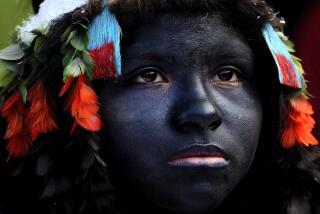Taiwan ritual honors lost tribe of ‘small people’
- Share via
XIANG TIAN HU, Taiwan — Chu Kuo-sheng danced for 24 hours in the cold mountain rain to draw attention to a seldom-discussed chapter of Taiwanese history. He linked arms with dozens of others, chanted and slowly shuffled across a field.
About 600 people performed the exhausting ritual last weekend that honors a pygmy-like people, skin as dark as those from equatorial Africa, whom Chu’s own tribe admits to exterminating in battle between 1,000 and 2,000 years ago.
The ceremony, called Pasta’ay, is a tribute to a lost tribe of pygmies, who may have numbered 90,000 at their peak and resembled tribes living today in Papua New Guinea. They disappeared, leaving no archaeological records that point conclusively to their existence. But anthropologists believe they were wiped out by other tribes like the Saisiyat, of which Chu is a member.
The ceremony is held every two years to thank the vanquished tribe for teaching its neighbors how to farm when they shared a steep, forested region of Taiwan just south of today’s main high-tech district.
“It’s a pact between us and the short people, when this time comes, to perform the ceremony, and to skip it would be a violation,” Chu, 48, said at a boisterous dinner, its attendees dressed in traditional red and white robes and ready to dance. “According to information from our elders, they gave us what we needed to work, farm and get by.”
Historians in Taiwan say the tribe was ethnically linked to short, dark-skinned people who still live in Southeast Asia, including Malaysia and the Philippines. Elsewhere in Asia, they are known as negritos.
It is the people who killed them who now seek to tell their story, as they have done through rituals since before anyone can remember.
The Saisiyat, who have lighter skin and Asiatic features, killed the last of the pygmies in battle over a classic issue among men, local elders say: The pygmies would pursue Saisiyat women, enraging the tribe.
The Saisiyat ultimately forced a battle, cornering so many pygmies on a bridge that the entire tribe drowned when warriors damaged the span, tipping it into a mountain river, said Chu Fung-lu, master of ceremonies at the second of Taiwan’s two biennial Pasta’ay ceremonies that are held around Xiang Tian Hu, a village in mountainous northwestern Taiwan, whose name means “toward Heaven Lake.”
Pygmies may have reached Taiwan from Madagascar via the islands of Southeast Asia, scholars say. The Taiwanese government’s Council of Aboriginal Affairs acknowledges the dark-skinned tribe, called the “small people” in Mandarin Chinese.
“We may have only legends, but everyone knows the pygmies were around,” said Pan Chiu-jung, a commissioner for the government of Miaoli county, where the Xiang Tian Hu ceremony took place.
Almost all the Saisiyat were expected to drop by one of two ceremonies, which ended Monday. The tribe is one of 14 recognized indigenous groups in Taiwan, where it would traditionally hunt in the island’s high central mountains. Over the last 50 years, the Saisiyat have moved to cities for work, often forming an invisible underclass.
For the ritual’s opening night in Xiang Tian Hu, ethnic Han Chinese from around Taiwan packed shuttle buses that rumbled up a curvy mountain road to the ceremony venue half an hour from the nearest town. About 98% of Taiwan’s 23 million people are Han.
Huddled in rain slickers, the spectators took photos as groups of Saisiyat men in costume chanted and danced their way across a field — after finishing large, meaty meals along with nonstop alcohol.
“The pygmies were really accomplished, but they had one bad habit, which is that they were lustful,” said Hu Lee-fen, who watched the festival on opening night. “But this is my first time here. I’ve done my homework, but I want to know more.”
Jennings is a special correspondent.
More to Read
Sign up for Essential California
The most important California stories and recommendations in your inbox every morning.
You may occasionally receive promotional content from the Los Angeles Times.













